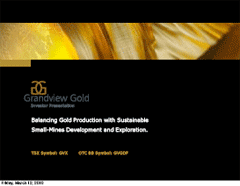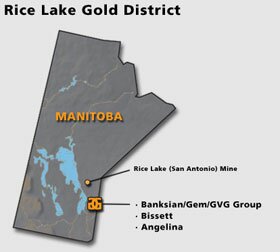» Peru
» Red Lake Gold District
¦ Regional Activity
¦ Regional Geology
¦ Past Exploration
¦ Deposit Types
¦ Mineralization
¦ Geology
¦ Past Exploration
¦ Deposit Types
¦ Mineralization
¦ Drilling Results
¦ Resource Estimates


Rice Lake Gold District

The Rice Lake Gold District in 'mining-friendly' Manitoba is an emerging gold district located approximately 80 kilometres west of the prolific Red Lake Mining District in Ontario. The Red Lake Mining District has produced over 30 million ounces of gold and is home to Goldcorp's 11 million ounce Red Lake Mine complex which produces over 600,000 ounces of gold per year. See the Red Lake Gold District pages of this website for details.
The Red Lake and Rice Lake Mining Districts share many geologic features. They lie in the same geological terrain, on the same crustal fault and are structurally very similar. Like the Red Lake greenstone belt, the Rice Lake greenstone belt is part of the Superior Province and Uchi Subprovince. What separates the districts from each other is their exploration history and the border between the provinces of Manitoba and Ontario.
In spite of its similarities to the Red Lake Gold District, the Rice Lake District remains virtually un-explored, having produced about 10% of the gold produced by the Red Lake District.
Industry estimates suggest that Rice Lake exploration activity runs at about 20% of Red Lake levels, and expenditures at about one to two percent. Most mining activity took place prior to WWII and the advent of even pre-modern exploration techniques.
Between 1919 and the beginning of the second world war, the Rice Lake District experienced a small gold rush with about a dozen small mines operating on the belt. Surface exploration undertaken at the time resulted in the eventual discovery of almost all of the deposits know today. Technology did not allow deep drilling so most of the exploration was done above 500 feet. In contrast, most recent discoveries have been made below 1,000 feet.
The Rice Lake Mine, formerly San Antonio Mine operated between 1932 and 1968 and again between 1982 and 1983 has produced approximately 1.4 million ounces of gold, or 80% of total Rice Lake output. The mine was recently re-opened and has approximately one million ounces in proven and probable reserves.
Manitoba is considered 'mining-friendly' as the provincial government holds exploration and mining activity in high regard as catalysts for economic growth. Exploration companies have the support of the province's Mineral Exploration Assistance Program (MEAP), which provides subsidies to qualifying companies, on eligible expenses. A variety of tax credits and incentives exist also.
In spite of limited mining activity over the century, a well-developed infrastructure exists in the province and the Manitoba Bureau of Mines has an excellent and easily accessible land survey and geoscience database. The province has been recognized by resource companies and independent public policy organizations alike for its mining friendly policies. Presently, according to a Fraser Institute survey of junior and major resource companies, Manitoba ranks first in Canada and third in the world for its mineral policies.
Grandview has several gold properties and a joint venture project in the Rice Lake Gold Belt, and one early stage development project about 60 miles south in the historic Lac du Bonnet Mining District.
Cautionary Note to U.S. Investors - The United States Securities and Exchange Commission permits U.S. mining companies, in their filings with the SEC, to disclose only those mineral deposits that a company can economically and legally extract or produce. Grandview uses certain terms on its website (and certain press releases), such as "measured," "indicated," and "inferred," "resources," which the SEC guidelines strictly prohibit U.S. companies from including in their filings with the SEC. U.S. Investors are urged to consider closely the disclosure under the heading "Cautionary Note to U.S. Investors Regarding Mineral Reserve and Resource Estimates" in our latest annual report on Form 20-F which may be secured from us, or from the SEC's website at http://www.sec.gov/edgar.shtml.
This website contains information about adjacent properties on which we have no right to explore or mine. We advise U.S. investors that the SEC's mining guidelines strictly prohibit information of this type in documents files with the SEC. U.S. investors are cautioned that mineral deposits on adjacent properties are not indicative of mineral deposits on our properties.











